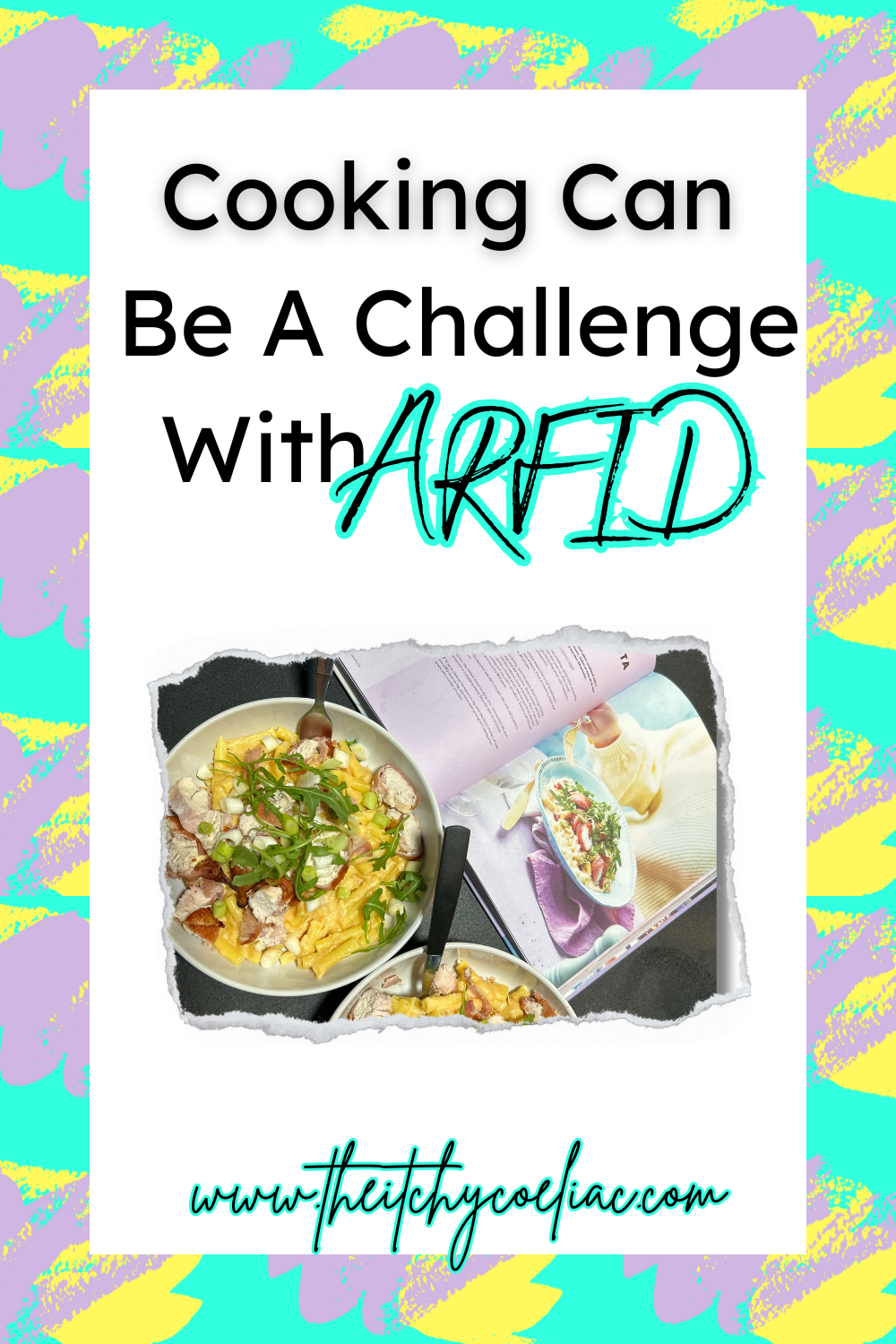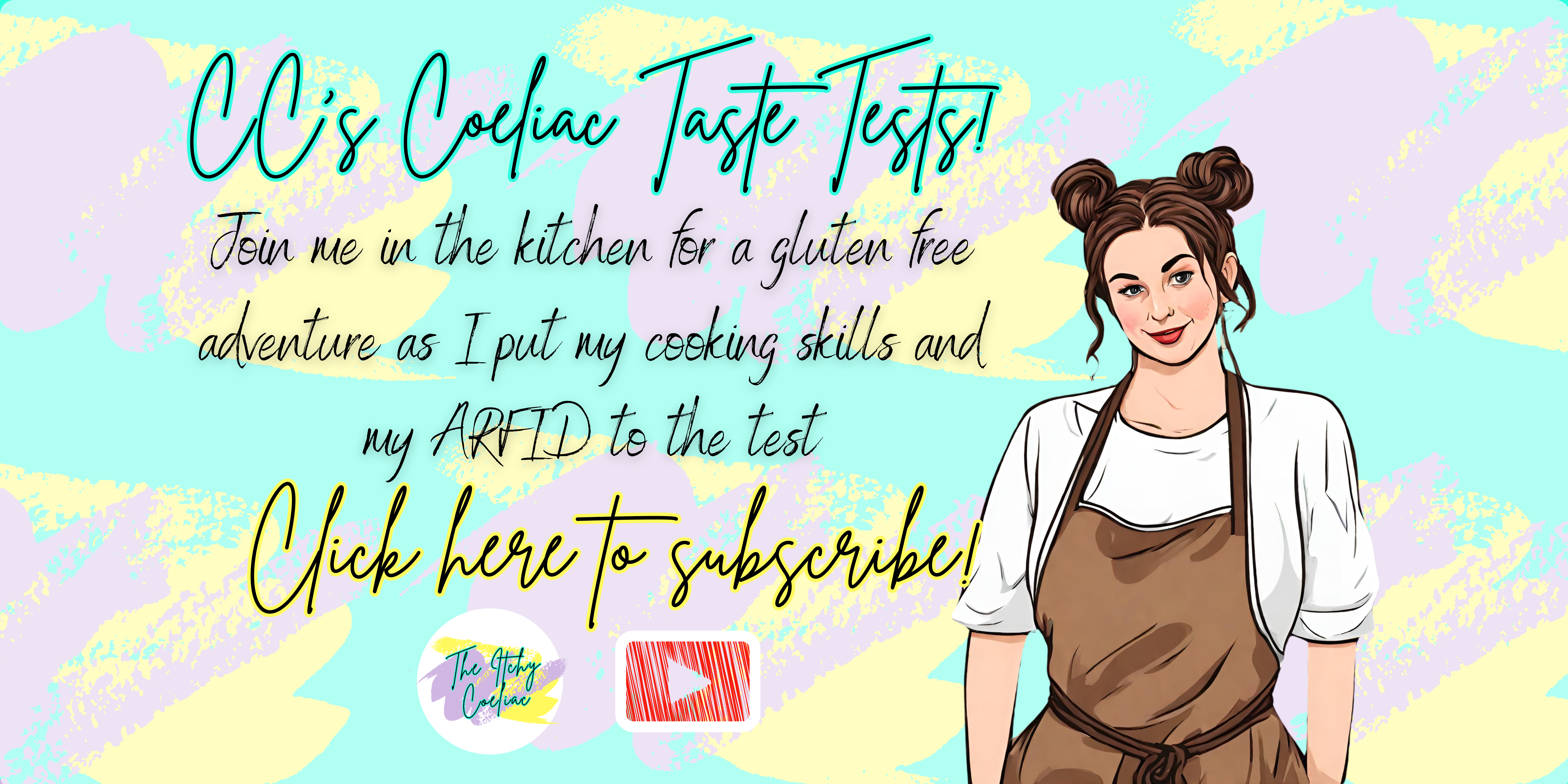A big struggle that people with ARFID face is their lack of knowledge in the kitchen! We typically have little reason to adventure into the wonderful world of cooking. This can mean that we’re often left questioning even the simplest of things.
Others might think it crazy that we don’t have a clue how to cut a spring onion or how to fry an egg. Well, I’m going to let you in on the secret of why cooking when you struggle with ARFID can be such a challenge!
Why not pin it for later?
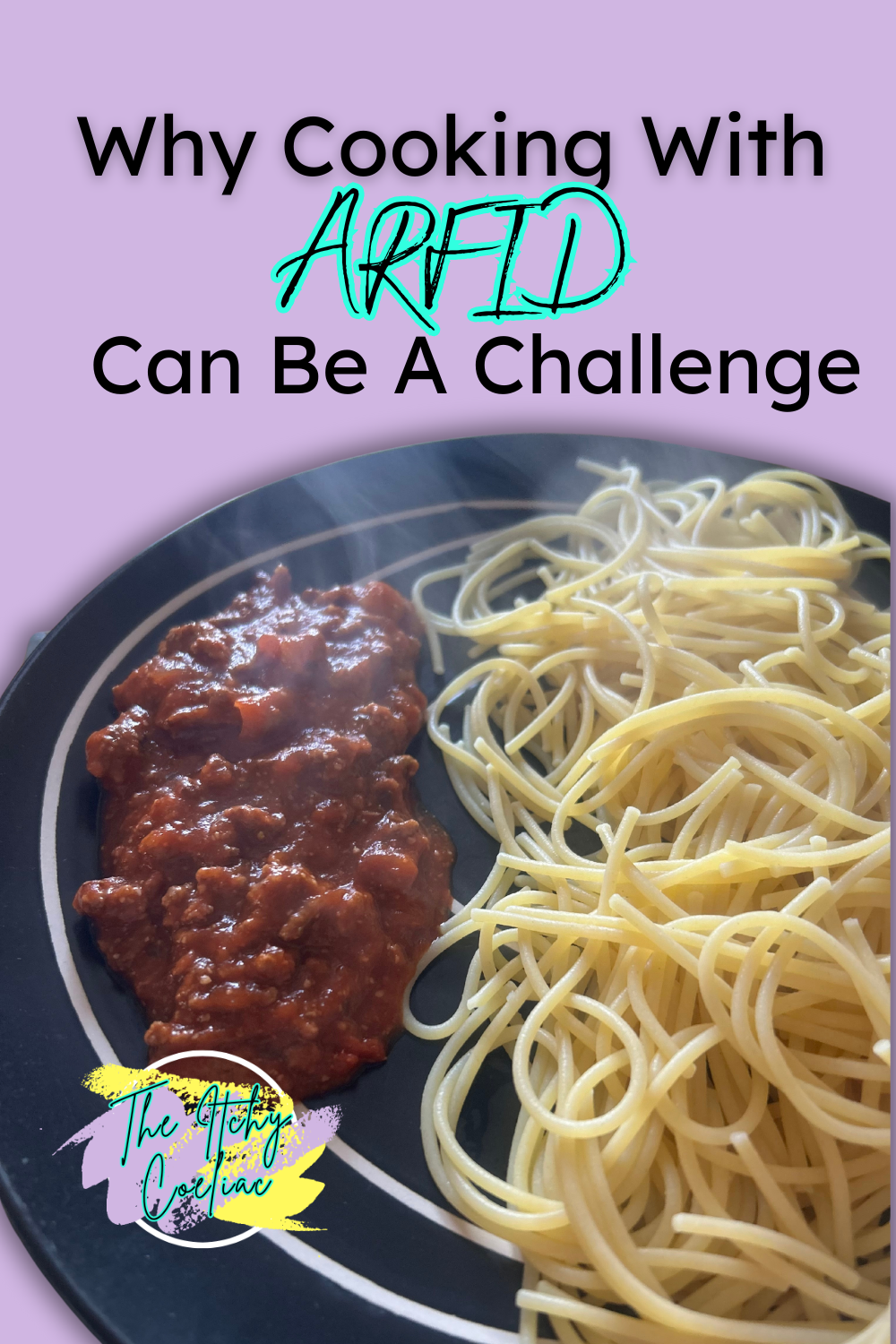
Have you been keeping up to date with my social media? Then you’ll know that The Itchy Coeliac is about to drop its first ever video series! Exciting!
It’s a series where I’m joined in the kitchen with my sister. We’re cooking gluten free meals together (despite neither of us being able to make much more than instant noodles!). We’ll be making a range of different dishes, pushing me out of my comfort zone as I sit down at the table with her to give things a try.
This week we filmed Episode 1 and it got me thinking. There are a lot of people who don’t realise just how difficult cooking can be when you have ARFID. Not only that, but we often lack the basic cooking skills others have.
I want to bring a bit more awareness to this issue. It’s something that can often be cause for ridicule or feelings of inadequacy – despite having perfectly valid reasons!
We like to keep it simple
Let’s first look into the reason that we don’t know much about what it’s like to be a gourmet chef! It’s really simple when you think about it.
Most people with ARFID prefer foods that can be dependable, consistent and simple. This is because we will always know what to expect when we eat them. We’ll recognise the packaging, the taste, the smell, the feel.
This familiarity provides the comfort we need to be able to eat that food comfortably. These foods tend to be things like snacks, crisps, microwave meals, simple freezer to oven items.
For this reason, there doesn’t tend to be much cooking involved! You can just grab that packet of crisps from the cupboard. Or you can just put the pizza straight in the oven.
Usually food that needs to be cooked is much more complex and uses more ingredients than we might be comfortable with. Plus depending on who’s making it and how, it can be inconsistent.
For this reason, people with ARFID are not usually masters in the kitchen. It’s important to note this might not apply to everyone! I’m just speaking from my own personal experience on this one.
I’ve never needed to know how to cook lasagne because it’s not something I would ever eat. I didn’t have the motivation to learn how to defrost and roast a chicken. I’d never choose to make that for myself so why would I?
That being said – I can tell you how to time your frozen pizza to get the edges crispy but the cheese in the middle melted just right!
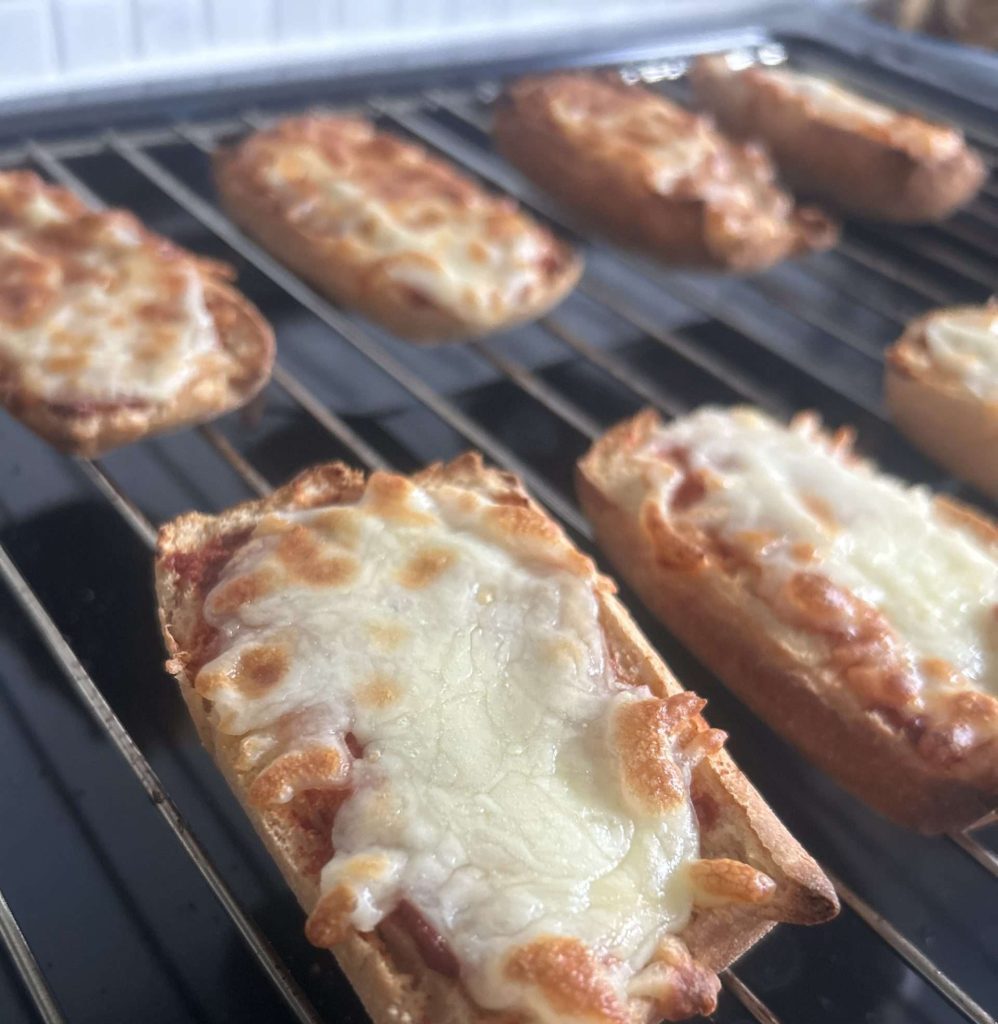
Cooking with ARFID can be heavy on the senses
One subtype of ARFID is called ‘Avoidant ARFID’. This is when we struggle due to sensory issues such as taste, smell and texture of foods. As you can imagine, this can make cooking a little tricky!
While filming the first episode of CC’s Coeliac Taste Tests, one thing I noticed very early on was how difficult I found it to handle some of the ingredients.
Certain smells and textures can be very triggering and cause anxiety when it comes to actually eating the food. Because of this, we might choose to stay away from cooking so we don’t have to deal with those triggers.
For me, the handling of raw chicken was a difficult one. It was very slimy and wet and made alarm bells ring in my head. Why? I’m not really sure. Sometimes even we don’t understand why we are reacting the way we are.
Another one I struggled with was BBQ sauce.
From the moment I read the recipe, that particular ingredient stuck with me. I’ve always had issues with condiments so I knew that would be a challenge.
Even from handling the bottle I was feeling anxious. For the most part I made my sister deal with it because I knew it was worrying me. Both the smell and the look of it made me feel on edge. Even now, I know that I’m going to ask her to put it in the top shelf of my cupboard and that’s where it’ll stay for the rest of time.
When there are certain ingredients involved in a recipe, people with ARFID may shy away from trying to cook them. It’s just not worth the stress of having to use the product when we know our simple safe foods are readily available.
There are other sensory issues to take into consideration as well. A lot of times when cooking, things can become more assaulting to the senses as you go.
Onions are a good example of this. While the smell might be minimal when it’s on the table, when you cut into it you’re suddenly surrounded by it and it becomes very strong.
This can be true for how foods look also. After being cooked, the look and texture of foods can change. Watching something you love turn into a big goopy mess isn’t always fun! Regardless of how it might taste.
For someone who deals with the avoidant side of ARFID, cooking can really be a challenge. Having to manage your thoughts and feelings towards so many smells, textures and tastes all at once can definitely be an overwhelming experience.
We’re not often exposed to cooking experiences
The social aspects of having ARFID can be limiting in more ways than you might think. One of these is that by not going out and enjoying new foods and cooking experiences, we don’t acquire the knowledge that others might.
Most people tend to pick up ideas for new dishes and how to cook them when they eat out at restaurants or at a friend’s house.
When you have ARFID, you’re less likely to do these things because of your limitations with food. It can come from fear of coming into contact with fear foods or from the judgement of others for the way we eat.
This means that we not only have little motivation to cook new foods but we don’t have that experience of seeing others cooking and trying new foods either. So we fail to pick up those skills in the kitchen.
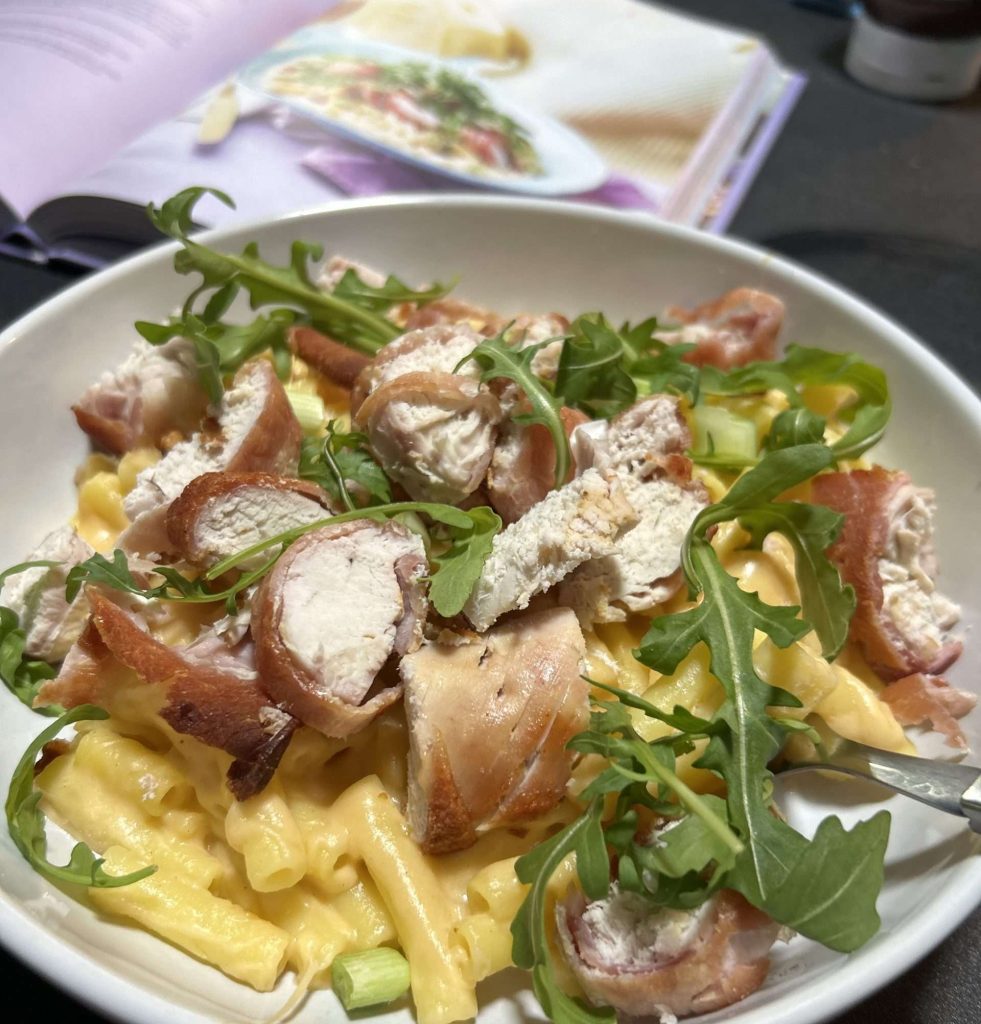
It’s often recommended for those who are working through ARFID with therapy and coping techniques, that they get in the kitchen themselves. It can sometimes be helpful to see exactly what is going into the dish you’re making. It’s also a good chance to get used to being around foods that cause us stress.
You’re able to handle the food and explore it in a safe way that you can control. By regularly cooking meals, you will begin to alleviate the fears associated with it.
Exposure through cooking can be a good method as it makes something which is normally stressful, into something that could be a fun experience instead. You can do it with your family or friends and it helps relieve some of that pressure from trying new foods.
And you don’t even have to eat what you make. Being able to tolerate a smell or to touch a texture you previously wouldn’t is still brilliant progress.
We might have a previous negative experience
People that struggle with aversive ARFID have a fear of potentially choking, gagging or vomiting from their food. If this is something they’ve experienced before, the fear can then reach outwards to include the preparation of food.
If our anxiety is high from a previous negative experience, we are a lot less likely to want to jump into making that food again. In fact, we would probably just try to avoid it altogether!
This stress caused by the bad experience creates almost a mental block towards the food and extends to anything to do with it.
For someone with this type of ARFID, cooking can be very difficult. They’re not only trying to get over the fear of what might happen to them when they eat the food. But they’re also having to deal with it mounting over time while they prepare it.
The best way to try and make cooking an easier experience in this case is by making sure there is no pressure. Don’t get too bogged down in the idea that you must make the dish and then you must sit down and eat it.
Only do what you feel comfortable with. If it pushes your anxiety too far, then leave it to someone else. The fact that you’re willing to even try is what matters.
Do you know someone with ARFID and think cooking their meals might help to alleviate their fears around food? Make sure to read about how to best support them through it in this post 7 Helpful Ways to Support Someone With ARFID!
We’re not competing in Masterchef!
The biggest thing I want people to take away from this post is that people with ARFID should not be judged on their cooking skills.
There have been times where I’ve asked a cooking question and been met with a blank stare. Promptly followed by “How do you not know how to do that?”
I’m sorry! I’ve never had to cook properly before! All I’ve eaten for the majority of my life is bread, butter and microchips!
It can definitely be frustrating when you’re made to feel like you’re stupid for not knowing ‘simple’ things. They may be simple, but when you’ve not had any need to think about it before, how are you supposed to know?
This kind of attitude towards people with ARFID adds into the idea that ARFID is a child’s disorder. It’s like it’s being suggested that we never learned basic cooking skills and so we’ve never really grown up. Which of course, isn’t true.
Now I’m not saying it’s only people with ARFID that can face this kind of judgement but I have noticed that we are often called out on it.
It’s important to understand that we haven’t had those experiences that would give us the tools to know what to do. Even if we have, our biggest issue is that food gives us these unexplainable feelings of anxiety, stress and fear. It seems kind of a given that cooking or baking is going to pose some difficulty for us!
Let’s make the best of it
As someone who has lived her whole life with ARFID and has simply ‘gotten used to it’, I thought it might be time for me to give this cooking thing a try. What’s the worst that could happen?
That was why I came up with CC’s Coeliac Taste Tests. I thought it would be a great way to not only challenge myself and improve my cooking skills, but also to get people talking about issues like this one.
ARFID is often left out of the conversation entirely and when it is brought up, it’s not always with full understanding of the disorder. Thankfully, I am noticing a lot of amazing ARFID warriors fighting the fight on my socials (go check some of them out if you haven’t!) and I want to be a part of it!
I want to help bring it up more and show how it can really affect those that struggle with it. Hopefully, I can bring ARFID into some kind of spotlight while doing it in a fun and entertaining way. Plus, it’s a great way for me to find new gluten free dishes to make my Coeliac life a little easier!
CC’s Coeliac Taste Tests is out now so make sure to go follow my Youtube channel so you don’t miss future episodes! You can also find it here on the blog too.
I really hope this post has been helpful in explaining a little of why people with ARFID can often find cooking a struggle. This one feels a little all over the place and definitely a bit of a brain dump of mine! But it’s something I think is important to discuss.
Let me know if you did get something useful out of this article by leaving a comment below! I’d love to hear your thoughts.
